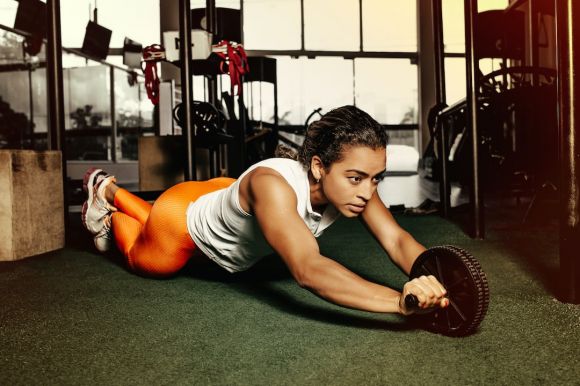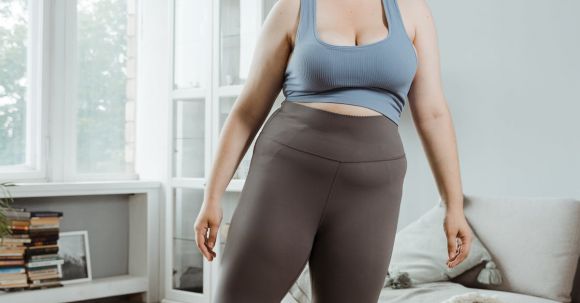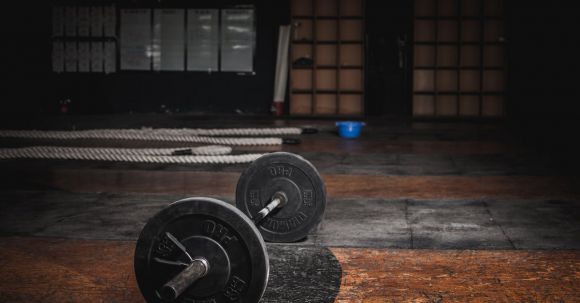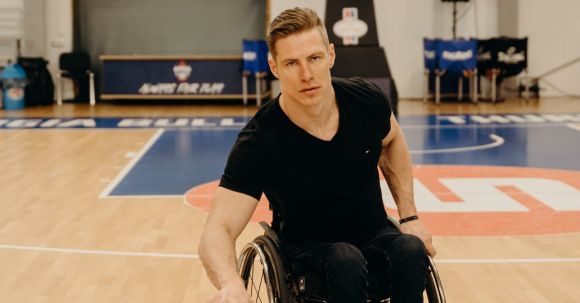As we age, it becomes increasingly important to prioritize our cardiovascular health. Engaging in regular physical activity can significantly reduce the risk of heart disease, stroke, and other cardiovascular conditions. In addition to maintaining a healthy diet and lifestyle, incorporating cardiovascular exercises into our daily routine is essential for promoting healthy aging. In this article, we will explore the benefits of cardiovascular exercises for seniors and provide some examples of exercises that can be easily incorporated into their fitness regimen.
Blog Posts
Are you tired of feeling sluggish and unmotivated? Do you want to improve your overall health and achieve your fitness goals? If so, it's time to embark on your ultimate fitness transformation journey. With the right mindset, dedication, and a solid plan, you can transform your body and achieve the results you've always dreamed of. In this article, we will guide you through the key steps you need to take to get fit and live a healthier, happier life.
Setting Clear Goals
The first step in your fitness transformation journey is to set clear and achievable goals. Take some time to reflect on what you want to accomplish and write down your goals. Whether it's losing weight, gaining muscle, or improving your cardiovascular fitness, be specific and realistic about what you want to achieve. Setting clear goals will help keep you motivated and focused throughout your journey.Creating a Workout Routine
Once you've set your goals, it's time to create a workout routine that suits your needs and preferences. Start by choosing activities that you enjoy and that align with your fitness goals. Incorporate a mix of cardiovascular exercises, strength training, and flexibility exercises to ensure a well-rounded workout routine. Remember to start slow and gradually increase the intensity and duration of your workouts to avoid injuries and burnout.Eating a Balanced Diet
Exercise alone won't give you the results you desire. To fuel your body and support your fitness goals, it's essential to eat a balanced diet. Focus on consuming whole foods that are rich in nutrients, such as fruits, vegetables, lean proteins, and whole grains. Avoid processed foods, sugary drinks, and excessive amounts of alcohol. Remember, what you put into your body directly impacts your energy levels, performance, and overall health.Staying Consistent
Consistency is key when it comes to achieving your fitness goals. Make exercise a non-negotiable part of your daily routine. Aim for at least 150 minutes of moderate-intensity aerobic activity or 75 minutes of vigorous-intensity activity per week, along with strength training exercises at least two days a week. Find ways to stay motivated and hold yourself accountable. Consider joining a fitness class, hiring a personal trainer, or finding a workout buddy to help keep you on track.Tracking Your Progress
To stay motivated and measure your success, it's important to track your progress along the way. Keep a journal or use a fitness tracking app to record your workouts, measurements, and how you feel throughout your journey. Celebrate small milestones and use setbacks as opportunities for growth. By tracking your progress, you'll be able to see how far you've come and stay motivated to keep pushing forward.Seeking Support
Embarking on a fitness transformation journey can sometimes feel overwhelming. Surround yourself with a supportive community of like-minded individuals who can offer guidance, motivation, and accountability. Consider joining a fitness group, hiring a personal trainer, or seeking support from friends and family. Having a support system in place can make a world of difference in staying motivated and achieving your goals.Embracing a Healthy Lifestyle
Finally, it's important to remember that fitness is not just about physical appearance. It's about embracing a healthy lifestyle that encompasses all aspects of your well-being. Get enough sleep, manage stress, and prioritize self-care. Incorporate activities that bring you joy and make you feel good. Remember, your fitness transformation journey is not just a destination, but a lifelong commitment to living a healthier, happier life. In conclusion, your ultimate fitness transformation journey starts with setting clear goals, creating a workout routine, eating a balanced diet, staying consistent, tracking your progress, seeking support, and embracing a healthy lifestyle. With dedication and perseverance, you can achieve your fitness goals and transform your body. Remember, it's not just about the end result, but the journey itself. So, lace up your sneakers, take that first step, and get fit on your ultimate fitness transformation journey.
Are you struggling to reach your fitness goals? Do you find it difficult to stay motivated and consistent with your workouts? If so, you're not alone. Many people face these challenges when trying to improve their fitness. The good news is that there are several ways you can get the support you need to overcome these obstacles and achieve your fitness goals. In this article, we will explore some effective strategies to help you stay on track and make progress towards a healthier, fitter you.
Find a Workout Buddy
One of the best ways to stay motivated and committed to your fitness journey is to find a workout buddy. Having a partner to exercise with can make your workouts more enjoyable and help keep you accountable. Your workout buddy can provide encouragement and support, making it easier for you to push through those tough days. Additionally, working out with a buddy can add an element of friendly competition, spurring you to achieve even better results.Join a Fitness Community
Another great way to get the support you need is to join a fitness community. Whether it's a local gym, a sports club, or an online group, being part of a community can provide you with a sense of belonging and motivation. Surrounding yourself with like-minded individuals who share similar goals can be incredibly inspiring and encouraging. You can exchange tips, share progress, and even participate in challenges together. The support and camaraderie you'll find in a fitness community can be a game-changer for your fitness journey.Hire a Personal Trainer
If you're looking for personalized guidance and support, hiring a personal trainer can be a wise investment. A trainer can assess your fitness level, create a customized workout plan, and provide ongoing motivation and accountability. They have the expertise to ensure you're performing exercises correctly and safely, maximizing your results. With a personal trainer by your side, you'll have someone who believes in your potential and pushes you to reach new heights.Track Your Progress
Tracking your progress is crucial when it comes to achieving your fitness goals. By keeping a record of your workouts, measurements, and achievements, you can see how far you've come and stay motivated to keep going. There are various tools available to help you track your progress, such as fitness apps, wearable devices, or simply pen and paper. The act of tracking itself can provide a sense of accomplishment and remind you of the progress you've made, even on days when you feel discouraged.Reward Yourself
Lastly, don't forget to reward yourself along the way. Celebrate your milestones and achievements, no matter how small they may seem. Treat yourself to something you enjoy, like a massage, a new workout outfit, or a day off. By acknowledging and rewarding your efforts, you'll reinforce positive behavior and motivate yourself to continue working towards your fitness goals. In conclusion, reaching your fitness goals requires commitment, dedication, and support. By finding a workout buddy, joining a fitness community, hiring a personal trainer, tracking your progress, and rewarding yourself, you can create a support system that will help you stay motivated and focused on your fitness journey. Remember, you don't have to do it alone. With the right support, you can overcome any obstacles and achieve the healthy, fit lifestyle you desire. So, start today and get the support you need to reach your fitness goals.
In today's fast-paced world, finding time to prioritize our health and fitness can be a challenging task. With numerous responsibilities and a hectic schedule, many people struggle to maintain a balanced and healthy lifestyle. However, thanks to the advancements in technology, online personal training has emerged as a convenient and effective solution. With the help of a virtual personal trainer, you can achieve your fitness goals and improve your overall well-being from the comfort of your own home. Let's explore how online personal training can help you achieve a balanced and healthy lifestyle.
Flexibility and Convenience
One of the biggest advantages of online personal training is the flexibility it offers. Unlike traditional personal training, where you have to adhere to a fixed schedule, online training allows you to work out at a time that suits you best. Whether you're an early bird or a night owl, you can fit your exercise routine into your daily routine without any hassle. This flexibility ensures that you never miss a workout session, enabling you to stay on track with your fitness goals.Personalized Training Plans
Another key benefit of online personal training is the personalized training plans that are tailored to your specific needs and goals. When you sign up for online training, you will have an initial consultation with your virtual trainer to discuss your objectives, fitness level, and any limitations you may have. Based on this information, your trainer will create a customized workout plan that targets your individual goals. This personalized approach maximizes the effectiveness of your training sessions, ensuring that you make progress towards your desired outcomes.Constant Support and Accountability
Staying motivated on your fitness journey can be challenging, especially when you're working out alone. However, with online personal training, you have a constant source of support and accountability. Your virtual trainer will be with you every step of the way, providing guidance, encouragement, and feedback. They will monitor your progress, make necessary adjustments to your training plan, and answer any questions or concerns you may have. This support system helps you stay motivated, accountable, and on track towards achieving a balanced and healthy lifestyle.Access to a Wide Range of Resources
In addition to personalized training plans and ongoing support, online personal training also provides you with access to a wealth of resources. Virtual trainers often offer a variety of workout videos, meal plans, and educational materials that can enhance your fitness journey. These resources can help you expand your knowledge about nutrition, exercise techniques, and overall wellness. By having access to a wide range of resources, you can make informed choices and adopt healthy habits that will benefit you in the long run. In conclusion, online personal training is a convenient and effective way to achieve a balanced and healthy lifestyle. With its flexibility, personalized training plans, constant support, and access to valuable resources, online training provides you with the tools and guidance necessary to reach your fitness goals. So, if you're looking to prioritize your health and well-being, consider embracing the world of online personal training and start your journey towards a healthier and happier you.Introduction
In today's health-conscious society, there is no shortage of popular diets promising quick weight loss and improved well-being. From low-carb to intermittent fasting, the options are endless. While these diets may offer some benefits, they also come with their fair share of drawbacks. In this article, we will explore the pros and cons of popular diets, helping you make an informed decision about which approach is right for you.The Low-Carb Diet
Pros: The low-carb diet, such as the ketogenic diet, can be effective for weight loss. By reducing your carbohydrate intake and increasing your consumption of healthy fats, you can promote fat burning and feel satiated for longer periods. This diet may also improve blood sugar control and reduce the risk of certain chronic diseases, such as type 2 diabetes. Cons: However, the low-carb diet can be challenging to sustain long-term. It often requires strict adherence and may lead to nutrient deficiencies if not carefully planned. Additionally, some individuals may experience unpleasant side effects, such as the "keto flu" during the initial adaptation phase.The Mediterranean Diet
Pros: The Mediterranean diet emphasizes whole foods, including fruits, vegetables, whole grains, legumes, and lean proteins, while limiting processed foods and saturated fats. It has been associated with numerous health benefits, including reduced risk of heart disease, stroke, and certain cancers. This diet is also known for its flexibility and sustainability, making it a popular choice for many. Cons: While the Mediterranean diet offers many advantages, it may not be suitable for everyone. Its emphasis on whole grains and legumes can be problematic for individuals with certain medical conditions, such as celiac disease or irritable bowel syndrome. Additionally, some people may find the Mediterranean diet too high in calories for weight loss purposes.Intermittent Fasting
Pros: Intermittent fasting involves cycling between periods of eating and fasting. This approach has been shown to promote weight loss, improve insulin sensitivity, and even enhance brain function. It can also simplify meal planning and reduce the need for constant snacking, making it convenient for some individuals. Cons: Despite its potential benefits, intermittent fasting may not be suitable for everyone. It can be challenging to adhere to, especially in social situations or for individuals with a history of disordered eating. Some people may also experience side effects such as fatigue, irritability, or difficulty concentrating during fasting periods.The Paleo Diet
Pros: The paleo diet aims to mimic the eating habits of our ancient ancestors, focusing on whole, unprocessed foods. By eliminating grains, legumes, and dairy, it encourages the consumption of lean proteins, fruits, vegetables, and healthy fats. Many people find that this diet helps reduce inflammation and promotes weight loss. Cons: While the paleo diet has its merits, it may not be suitable for everyone. By excluding entire food groups, such as grains and dairy, it can be challenging to meet all of your nutritional needs. Additionally, the paleo diet may be more expensive and time-consuming to follow, as it often requires sourcing organic and grass-fed products.Conclusion
When it comes to choosing a diet, it's essential to consider both the pros and cons. While low-carb diets may offer quick weight loss, they can be difficult to sustain. The Mediterranean diet may be flexible and heart-healthy, but it may not be suitable for everyone. Intermittent fasting can simplify meal planning, but it may not be suitable for individuals with a history of disordered eating. Lastly, the paleo diet may reduce inflammation, but it can be challenging to meet nutritional needs and more expensive to follow. Ultimately, the best diet is one that is personalized to your individual needs and preferences. Consulting with a healthcare professional or registered dietitian can help you find the right approach that promotes both your physical and mental well-being. Remember, there is no one-size-fits-all solution, and it's important to listen to your body and make choices that support your long-term health goals.
Flexibility plays a crucial role in our overall well-being. It allows us to move more freely and perform daily tasks with ease. Whether you're an athlete looking to enhance your performance or simply want to improve your range of motion, incorporating home exercises into your routine can help you achieve your flexibility goals. In this article, we will explore various exercises that you can do in the comfort of your own home to enhance your flexibility.
Stretching for Flexibility
Stretching is a fundamental practice for improving flexibility. It helps to elongate the muscles and connective tissues, increasing their range of motion. Here are some effective stretching exercises you can try: 1. Hamstring Stretch: Sit on the floor with one leg extended and the other bent. Reach forward and try to touch your toes, feeling the stretch in the back of your thigh. 2. Quadriceps Stretch: Stand upright and bend one knee, bringing your foot towards your glutes. Grab your ankle and gently pull it closer to your body, feeling the stretch in the front of your thigh. 3. Shoulder Stretch: Stand with your feet shoulder-width apart. Take one arm across your chest and use your other arm to hold it in place, feeling the stretch in your shoulder and upper back. 4. Hip Flexor Stretch: Kneel on one knee and place the other foot flat on the ground in front of you. Lean forward, keeping your back straight, and feel the stretch in the front of your hip.Yoga for Flexibility
Yoga is a fantastic way to improve flexibility while also promoting relaxation and mindfulness. There are many yoga poses that specifically target different muscle groups. Here are a few poses to incorporate into your home practice: 1. Downward Dog: Start on all fours, then lift your hips up and back, forming an inverted V shape with your body. This pose stretches the hamstrings, calves, and shoulders. 2. Pigeon Pose: Begin in a plank position, then bring one knee forward and place it near your wrist. Extend the opposite leg back and lower yourself down, feeling the stretch in your hip and glutes. 3. Standing Forward Fold: Stand with your feet hip-width apart, then hinge forward at the hips, reaching for your toes. This pose stretches the hamstrings and lower back. 4. Bridge Pose: Lie on your back with your knees bent and feet flat on the ground. Lift your hips off the floor, creating a bridge shape with your body. This pose stretches the chest, shoulders, and hip flexors.Incorporating Dynamic Movements
Dynamic movements involve active stretching and can be an excellent addition to your flexibility routine. These movements help to improve mobility and warm up the muscles before engaging in any physical activity. Here are a few dynamic exercises to try: 1. Arm Circles: Stand with your feet shoulder-width apart and extend your arms out to the sides. Make small circles with your arms, gradually increasing the size of the circles. 2. Leg Swings: Stand next to a wall or support and swing one leg forward and backward in a controlled manner. Repeat on the other leg. 3. Trunk Rotations: Stand with your feet shoulder-width apart and place your hands on your hips. Rotate your torso to one side, then to the other side, feeling the stretch in your obliques and lower back. 4. Lunge with a Twist: Step forward into a lunge position, then twist your torso towards the front leg. Return to the starting position and repeat on the other side. In conclusion, improving flexibility through home exercises is both accessible and effective. By incorporating stretching exercises, yoga poses, and dynamic movements into your routine, you can gradually enhance your range of motion and overall flexibility. Remember to listen to your body, start slowly, and gradually increase the intensity and duration of your exercises. With consistent practice, you will notice significant improvements in your flexibility, leading to better physical performance and overall well-being. So why wait? Start implementing these exercises into your daily routine and enjoy the benefits of a more flexible body.
In the midst of a pandemic, finding ways to stay fit and healthy has become more important than ever. With gyms closed and outdoor activities limited, many people have turned to home workouts as a way to maintain their fitness levels. While it may seem challenging to build endurance without the use of gym equipment, there are plenty of effective exercises that can be done at home to help you increase your stamina. In this article, we will explore some of the best ways to build endurance with home workouts.
HIIT Training: A Time-Efficient Option
High-Intensity Interval Training, or HIIT, is a form of exercise that involves short bursts of intense activity followed by periods of rest or low-intensity exercise. This type of training has been proven to be highly effective in improving endurance. The beauty of HIIT is that it can be done with minimal equipment and in a relatively short amount of time. A typical HIIT workout might include exercises such as burpees, jumping jacks, and mountain climbers. By pushing yourself to your maximum effort during the intense intervals, you will challenge your cardiovascular system and build endurance over time.Bodyweight Exercises: No Equipment Needed
One of the great things about home workouts is that you don't need fancy equipment to get a good workout. Bodyweight exercises are a fantastic way to build endurance and strength using only your own body as resistance. Exercises like squats, lunges, push-ups, and planks engage multiple muscle groups and elevate your heart rate, helping to improve your endurance. By gradually increasing the number of repetitions or the duration of each exercise, you can gradually build up your stamina and endurance.Circuit Training: Keep Your Heart Rate Up
Circuit training is a form of exercise that combines strength training and cardiovascular exercises in a fast-paced, continuous manner. It involves performing a series of exercises back-to-back with little to no rest in between. By keeping your heart rate up throughout the workout, circuit training provides a great cardiovascular challenge and helps to improve endurance. You can create your own circuit by choosing a variety of exercises that target different muscle groups. Some examples include jumping jacks, push-ups, squats, and mountain climbers. Aim to complete each exercise for a set amount of time or a certain number of repetitions before moving on to the next one.Interval Running: A Great Cardio Workout
If you enjoy running, interval training can be a highly effective way to improve your endurance. Interval running involves alternating between periods of high-intensity running and periods of low-intensity recovery. For example, you might sprint for 30 seconds and then jog or walk for one minute before repeating the cycle. This type of training challenges your cardiovascular system by pushing it to work harder during the intense intervals, while also allowing for recovery periods to prevent overexertion. Gradually increase the duration or intensity of the high-intensity intervals over time to continue building your endurance.Stay Consistent and Make It Fun
Consistency is key when it comes to building endurance. Aim to incorporate home workouts into your routine on a regular basis, whether it's daily or a few times a week. Find exercises or workouts that you enjoy and that keep you motivated. Mix it up by trying different types of workouts or incorporating new exercises to keep things interesting. Remember, building endurance is a gradual process, so be patient with yourself and celebrate your progress along the way. In conclusion, building endurance with home workouts is entirely possible with the right approach. Whether you choose to incorporate HIIT training, bodyweight exercises, circuit training, or interval running, consistency and patience are key. Challenge yourself, push your limits, and most importantly, have fun while doing it. By following these tips, you can build your stamina and endurance from the comfort of your own home.
Are you and your partner looking for a fun and effective way to get fit together? Look no further than the Fit on Couples Fitness Challenge! This exciting program is designed specifically for couples who want to improve their health and fitness while bonding with their loved one. With a variety of workouts, nutrition tips, and supportive community, the Fit on Couples Fitness Challenge is the perfect way to achieve your fitness goals as a couple.
Why Join the Fit on Couples Fitness Challenge?
Working out with your partner has many benefits, and the Fit on Couples Fitness Challenge takes it to the next level. Here's why you should join: 1. Motivation and Accountability: When you have a fitness buddy, it's easier to stay motivated and committed to your goals. When you and your partner are both working towards the same goals, you can keep each other on track and push each other to reach new heights. 2. Fun and Bonding: Exercising together can be a lot of fun! It's a great way to spend quality time with your partner while also improving your health. The Fit on Couples Fitness Challenge includes a variety of workouts that are designed to be enjoyable and engaging, so you'll have a blast while getting fit. 3. Supportive Community: When you join the Fit on Couples Fitness Challenge, you become part of a supportive community of like-minded couples who are all striving to achieve their fitness goals. You can connect with other participants, share your progress, and get advice and encouragement along the way.What to Expect from the Fit on Couples Fitness Challenge
The Fit on Couples Fitness Challenge is a comprehensive program that covers all aspects of fitness. Here's what you can expect: 1. Workout Plans: The challenge includes a variety of workout plans that are specifically designed for couples. These workouts are tailored to your fitness level and goals, so you can progress at your own pace. From cardio and strength training to yoga and HIIT, there's something for everyone. 2. Nutrition Guidance: In addition to the workouts, the Fit on Couples Fitness Challenge also provides nutrition guidance to help you fuel your body for optimal performance. You'll learn about healthy eating habits, portion control, and how to make nutritious meals that both you and your partner will enjoy. 3. Progress Tracking: To help you stay on track and monitor your progress, the Fit on Couples Fitness Challenge provides tools for tracking your workouts, nutrition, and other health metrics. You can see how far you've come and celebrate your achievements along the way.Join the Fit on Couples Fitness Challenge Today
Ready to take your fitness journey to the next level with your partner? Join the Fit on Couples Fitness Challenge today and start working towards your goals together. Whether you're just starting out or are already active, this program is designed to meet you where you're at and help you achieve real results. Don't wait any longer – get fit on with your partner and join the Fit on Couples Fitness Challenge today! Your health and happiness are worth it.
In today's fast-paced world, finding time to hit the gym can be a challenge. However, getting stronger doesn't always require fancy equipment or a gym membership. Bodyweight exercises are an effective way to build strength and improve your overall fitness without the need for any additional equipment. In this article, we will explore some of the best bodyweight exercises that can help you get stronger.
Push-Ups: The Ultimate Upper Body Strength Builder
Push-ups are a classic bodyweight exercise that targets multiple muscles in your upper body, including your chest, shoulders, and triceps. To perform a push-up, start in a plank position with your hands slightly wider than shoulder-width apart. Lower your body until your chest almost touches the ground, then push back up to the starting position. If you find regular push-ups too challenging, you can modify them by performing them on your knees or against a wall. Aim to gradually increase the number of push-ups you can do to continuously challenge your muscles and build strength.Squats: Build Lower Body Strength and Stability
Squats are a fantastic exercise for building lower body strength and stability. They primarily target your quadriceps, hamstrings, and glutes. To perform a squat, stand with your feet shoulder-width apart and lower your body as if you were sitting back into a chair. Keep your chest lifted and your knees in line with your toes. Push through your heels to return to the starting position. To add intensity to your squats, you can try jump squats or pistol squats, which are performed on one leg. Start with bodyweight squats and gradually increase the difficulty as your strength improves.Plank: Core Strength and Stability
The plank is a simple yet highly effective exercise for building core strength and stability. It targets your abdominal muscles, lower back, and shoulders. To perform a plank, start in a push-up position, then lower your forearms to the ground. Keep your body in a straight line from head to toe, and engage your core muscles. Hold this position for as long as you can, aiming to increase your time with each workout. To make the exercise more challenging, you can try side planks or plank variations, such as plank jacks or plank twists.Lunges: Strengthen Your Legs and Improve Balance
Lunges are a great bodyweight exercise for strengthening your legs and improving balance. They primarily target your quadriceps, hamstrings, and glutes. To perform a lunge, start with one foot forward and the other foot back. Lower your body until your front knee is at a 90-degree angle, then push through your front heel to return to the starting position. Alternate legs and aim to increase the number of lunges you can do over time. To add intensity, you can try walking lunges or jumping lunges.Get Stronger with Bodyweight Exercises
Getting stronger doesn't have to involve fancy equipment or a gym membership. Bodyweight exercises can be just as effective for building strength and improving overall fitness. Push-ups, squats, planks, and lunges are all excellent exercises that target multiple muscle groups and can be performed anywhere, anytime. Start with the basic variations of these exercises and gradually increase the difficulty as your strength improves. Consistency and progressive overload are key to getting stronger with bodyweight exercises. So, what are you waiting for? Start incorporating these exercises into your workout routine and watch your strength soar!
When it comes to improving your athletic ability, one-size-fits-all training methods simply won't cut it. To truly excel in your chosen sport, you need to engage in sports-specific training. This type of training focuses on the specific skills and movements required in your sport, helping you to develop the strength, speed, and agility needed to perform at your best. In this article, we will explore the benefits of sports-specific training and provide tips on how to incorporate it into your fitness routine.









